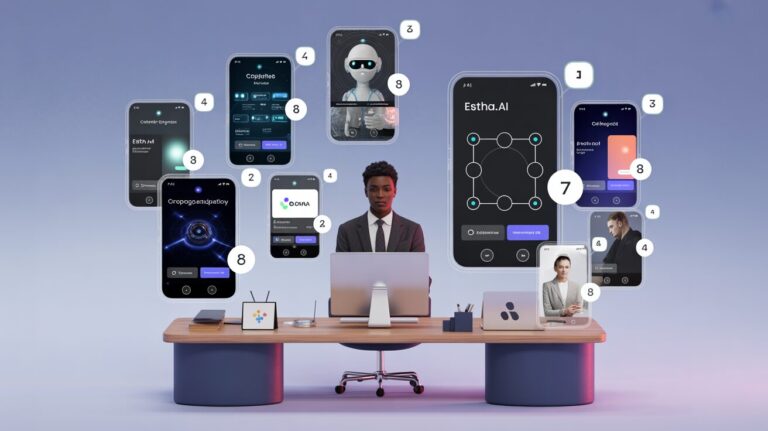Table Of Contents
- Understanding OAuth for No-Code AI Apps
- Why Secure Authentication Matters in AI Applications
- Common OAuth Flows Explained for Non-Technical Users
- Choosing the Right OAuth Flow for Your AI App
- Implementing OAuth in Your No-Code AI Application
- Best Practices for OAuth Security in No-Code Environments
- Troubleshooting Common OAuth Implementation Issues
- Future of Authentication for No-Code AI Applications
In today’s digital landscape, creating AI applications that securely handle user data isn’t just good practice—it’s essential. But traditionally, implementing secure authentication has been a significant hurdle for non-developers, requiring specialized knowledge of protocols, encryption, and security best practices.
That’s changing with the rise of no-code platforms. Now, professionals across industries can build sophisticated AI applications without writing a single line of code. However, one question remains: how do you ensure these applications are secure without deep technical expertise?
This is where OAuth comes in—a powerful authentication protocol that can be implemented even in no-code environments. Whether you’re a content creator building an AI assistant, an educator developing an intelligent tutoring system, or a business owner creating a customer service bot, understanding how to implement secure OAuth flows can be the difference between an application that users trust and one they avoid.
In this comprehensive guide, we’ll demystify OAuth authentication for no-code AI app builders, explaining the core concepts in accessible language, comparing different authentication flows, and providing step-by-step guidance for implementing secure user authentication in your AI applications—all without writing a single line of code.
Secure OAuth Flows for No-Code AI Apps
Essential implementation guide for non-technical creators
What is OAuth?
A secure authentication protocol that allows applications to access user data without exposing credentials—like a valet key that provides limited access.
Why It Matters for AI Apps
AI applications often process sensitive personal data, making robust security essential for building user trust and meeting compliance requirements.
Common OAuth Flows Compared
Authorization Code Flow
Most secure option with separate steps for authorization and token exchange.
Best for: Apps handling sensitive data like healthcare or financial information.
Implicit Flow
Simplified flow that returns tokens directly to the browser.
Best for: Simple applications with lower security needs (generally not recommended).
Client Credentials Flow
Server-to-server authentication without user involvement.
Best for: AI apps accessing resources independently of users (e.g., training models on licensed datasets).
Implementation in 5 Steps
Choose Identity Providers
Select which login options to offer (Google, Microsoft, Apple, etc.)
Register Your Application
Create OAuth credentials in each provider’s developer console
Configure Redirect URIs
Specify where users should be sent after authentication
Connect OAuth to Your No-Code Platform
Input credentials and configure user data mapping in your no-code tool
Test the Authentication Flow
Verify users can successfully log in and access appropriate features
Security Best Practices
Request Minimal Permissions
Only ask for the specific data your AI application needs
Implement Proper Scopes
Keep access permissions as narrow as possible
Enable Refresh Tokens
Maintain secure access without repeated logins
Create Clear Privacy Policy
Be transparent about how authentication data is used
Troubleshooting Tips
If users encounter login errors, verify that your redirect URI exactly matches the one in your OAuth provider settings. Even minor differences can cause authentication failures.
Estha: Empowering everyone to create secure AI applications without coding
Understanding OAuth for No-Code AI Apps
OAuth (Open Authorization) is an industry-standard protocol that allows applications to securely access user data from other services without exposing user credentials. For no-code AI app builders, OAuth provides a way to implement professional-grade security without diving into complex code.
At its core, OAuth is like a digital valet key for your users. Just as a valet key allows someone to park your car without accessing your glove compartment or trunk, OAuth lets users grant your AI application specific, limited access to their data on other platforms without sharing their passwords.
For example, when your AI chatbot needs to access a user’s calendar to schedule appointments, OAuth enables this connection securely. The user authenticates directly with their calendar provider (like Google), and your application receives only a token with specific permissions—never the user’s actual login credentials.
This security model is particularly important for AI applications, which often process sensitive user information to provide personalized experiences. By implementing OAuth, you’re not just adding a security feature—you’re building trust with your users by demonstrating a commitment to protecting their data.
Why Secure Authentication Matters in AI Applications
AI applications present unique security considerations that make proper authentication critical:
Data Sensitivity: AI applications often process highly personal data—from healthcare information to financial records—to deliver personalized experiences. Secure authentication ensures this sensitive information is accessed only by authorized users.
Trust Building: Users are increasingly aware of data privacy issues. Implementing visible security measures like familiar OAuth login screens from trusted providers (Google, Microsoft, Apple) signals to users that your application takes their privacy seriously.
Compliance Requirements: Depending on your industry, you may be subject to regulations like GDPR, HIPAA, or CCPA. Proper authentication is often a fundamental requirement for compliance with these standards.
Preventing AI-Specific Vulnerabilities: AI systems can be manipulated through unauthorized access, potentially leading to data poisoning or extraction of training data. Robust authentication forms your first line of defense against these specialized threats.
For no-code builders using platforms like Estha, implementing secure authentication isn’t just about avoiding breaches—it’s about creating professional-grade applications that can compete with traditionally developed software in terms of security and user confidence.
Common OAuth Flows Explained for Non-Technical Users
OAuth offers several different “flows” or methods for authentication, each designed for specific use cases. Understanding these flows in non-technical terms will help you choose the right approach for your AI application.
Authorization Code Flow
What it is: The most common and secure OAuth flow, ideal for applications that can securely store credentials.
How it works in simple terms: Think of this flow as a secure ticket exchange. When a user tries to access your AI app:
1. Your app directs them to the authorization server (like Google or Microsoft)
2. The user logs in directly with that provider
3. The provider gives your app a temporary ticket (authorization code)
4. Your app exchanges this ticket behind the scenes for an access token
5. The access token lets your app access permitted user data
Best for: Most no-code AI applications, especially those handling sensitive data like healthcare chatbots, financial advisors, or educational platforms with student information.
Implicit Flow
What it is: A simplified version of OAuth designed for applications running entirely in the browser.
How it works in simple terms: This is like a direct pass. When a user wants to access your AI app:
1. Your app sends them to the authorization server
2. The user logs in
3. The authorization server immediately gives the access token to the browser
4. The browser then uses this token to access protected resources
Best for: Simple AI applications with lower security requirements, such as content recommendation engines or basic chatbots. However, this flow is generally not recommended for most modern applications due to security limitations.
Client Credentials Flow
What it is: A server-to-server authentication flow that doesn’t involve an end user.
How it works in simple terms: This is like using a company ID badge rather than personal identification. Your AI application:
1. Uses its own credentials (not a user’s) to request access
2. Receives an access token
3. Uses this token to access resources it needs
Best for: AI applications that need to access resources independently of any user, such as training models on licensed datasets, accessing weather APIs, or retrieving non-user-specific information.
Choosing the Right OAuth Flow for Your AI App
Selecting the appropriate OAuth flow depends on several factors specific to your AI application:
Consider your user experience: The Authorization Code flow provides the most familiar and trusted login experience for users, with clear consent screens showing exactly what data your application is requesting.
Evaluate your data sensitivity: For AI applications dealing with personal, health, or financial information, the Authorization Code flow is strongly recommended for its enhanced security properties.
Assess your application architecture: If your no-code AI app is primarily used for accessing non-personalized APIs (like public data sources), the Client Credentials flow might be sufficient.
Remember mobile considerations: If your AI application will be accessed from mobile devices, ensure your chosen flow supports mobile optimization and potentially native app integration.
For most no-code AI applications built with platforms like Estha, the Authorization Code flow provides the best balance of security and usability. It’s widely supported by major identity providers and offers the most protection for your users’ data.
Implementing OAuth in Your No-Code AI Application
Implementing OAuth in a no-code environment is significantly simpler than traditional development, but still requires careful attention to detail. Here’s how to get started:
Setting Up OAuth Providers
1. Choose your identity providers: Start by deciding which login options you want to offer users. Common choices include:
– Google
– Microsoft/Azure AD
– Apple
– Facebook
– Twitter/X
2. Register your application: For each provider, you’ll need to register your application in their developer console:
– Google: Use the Google Cloud Console to create OAuth credentials
– Microsoft: Register your app in the Azure Portal
– Apple: Configure Sign in with Apple through the Apple Developer Program
3. Configure redirect URIs: During registration, you’ll need to specify where users should be sent after authentication. This is usually a URL provided by your no-code platform.
4. Obtain credentials: Each provider will give you credentials (Client ID and Client Secret) that your no-code platform will use to implement the OAuth flow.
Connecting OAuth to Your Estha AI App
Estha’s platform simplifies the OAuth implementation process through its visual interface:
1. Access the Authentication Settings: Within the Estha Studio interface, navigate to your app settings and locate the authentication configuration section.
2. Add OAuth Providers: Using the drag-and-drop interface, add the OAuth providers you’ve registered. You’ll need to input the Client ID and Client Secret obtained earlier.
3. Configure User Data Mapping: Define how user information from the OAuth provider (name, email, profile picture) should map to your application’s user profiles.
4. Set Up Authorization Rules: Using Estha’s visual rule builder, define which parts of your AI application require authentication and what level of access different user types should have.
5. Test the Flow: Before publishing, thoroughly test the authentication flow to ensure users can successfully log in and access the appropriate features of your AI application.
The beauty of implementing OAuth through a no-code platform like Estha is that complex security operations happen behind the scenes, allowing you to focus on creating an exceptional AI experience while maintaining enterprise-grade security.
Best Practices for OAuth Security in No-Code Environments
Even in a no-code environment, following security best practices is essential for protecting your users and their data:
Request minimal permissions: Only ask for the specific data your AI application needs. For example, if your app only needs to know a user’s name and email, don’t request access to their contacts or calendar.
Implement proper scope control: OAuth uses “scopes” to define what access your application has. Keep these as narrow as possible—a content recommendation AI likely doesn’t need write access to a user’s account.
Use state parameters: Most no-code platforms handle this automatically, but it’s worth confirming that your implementation includes state parameters to prevent cross-site request forgery attacks.
Enable refresh tokens: These allow your application to maintain secure access without requiring users to log in repeatedly.
Implement token storage securely: Your no-code platform should handle token storage, but verify that tokens are encrypted and stored securely, not in client-side accessible storage.
Set up monitoring: Configure alerts for unusual authentication patterns that might indicate a security breach, such as multiple failed login attempts or logins from unexpected locations.
Create a clear privacy policy: Be transparent with users about how their authentication data will be used and stored. This builds trust and is often legally required.
While no-code platforms abstract away much of the implementation complexity, understanding these security principles helps you configure your authentication system optimally and communicate security benefits to your users.
Troubleshooting Common OAuth Implementation Issues
Even with no-code platforms, you may encounter some challenges when implementing OAuth. Here are solutions to common issues:
Redirect URI Mismatch: If users encounter errors during login, verify that the redirect URI in your OAuth provider settings exactly matches the one generated by your no-code platform. Even minor differences like trailing slashes can cause authentication failures.
Token Expiration Problems: If users are unexpectedly logged out, check your refresh token implementation. Configure your OAuth settings to properly handle token expiration and renewal.
Scope Configuration Issues: If your AI application cannot access needed user data after authentication, verify that you’ve requested the appropriate scopes during the OAuth setup.
Mobile Authentication Challenges: Users accessing your AI app from mobile devices may experience different authentication flows. Ensure your OAuth implementation is responsive and works across devices.
Multiple Provider Conflicts: If you offer several login options (Google, Microsoft, etc.), ensure your user management system correctly handles accounts that might use different email addresses across services.
Most no-code platforms provide troubleshooting guides specific to their OAuth implementations. Referencing these resources can help resolve issues quickly without requiring deep technical knowledge.
Future of Authentication for No-Code AI Applications
As AI and no-code development continue to evolve, authentication methods are advancing as well. Stay informed about these emerging trends:
Passwordless Authentication: Technologies like WebAuthn and FIDO2 are making it possible to authenticate without passwords, using biometrics or security keys instead. Many OAuth providers are beginning to support these methods.
Contextual Authentication: AI-powered authentication systems that analyze user behavior patterns to determine if additional verification is needed are becoming more accessible to no-code platforms.
Decentralized Identity: Blockchain-based identity systems may eventually offer alternatives to traditional OAuth, giving users more control over their identity information.
AI-specific Authentication Protocols: As AI applications become more specialized, we may see authentication protocols designed specifically for machine learning systems, with built-in safeguards against model manipulation.
The good news for no-code builders is that platforms like Estha continually update their security features to incorporate these advancements, making cutting-edge authentication accessible without requiring you to implement complex protocols manually.
Implementing secure OAuth flows in your no-code AI applications doesn’t require a computer science degree or specialized security knowledge. With modern no-code platforms like Estha, enterprise-grade authentication is accessible to creators from all backgrounds.
By understanding the basic principles of OAuth, selecting the appropriate authentication flow for your specific use case, and following security best practices, you can create AI applications that not only deliver powerful functionality but also protect your users’ data and privacy.
Remember that security is not a one-time implementation but an ongoing commitment. As you develop and enhance your AI applications, regularly review your authentication mechanisms, stay informed about emerging security standards, and prioritize user privacy in every design decision.
With the right approach to authentication, your no-code AI applications can achieve the perfect balance of accessibility, functionality, and security—building user trust while delivering innovative AI experiences.
Ready to build secure AI applications without coding?
Experience how easy it can be to create powerful, secure AI apps with Estha’s intuitive no-code platform.



